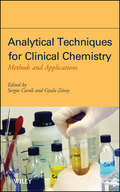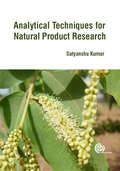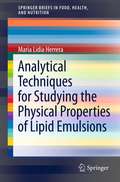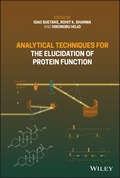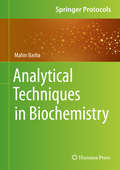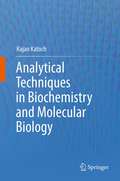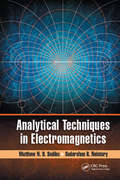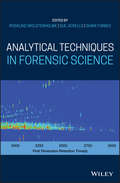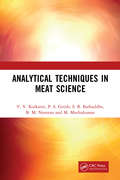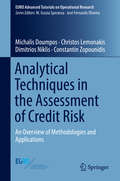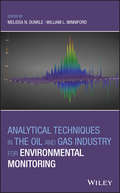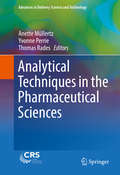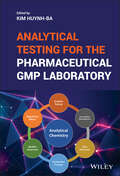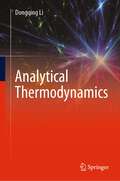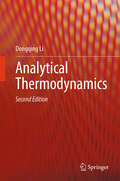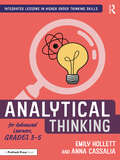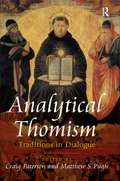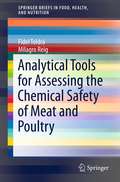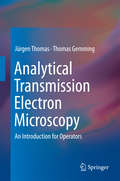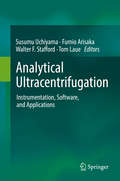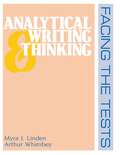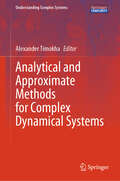- Table View
- List View
Analytical Techniques for Clinical Chemistry
by Sergio Caroli Gyula ZárayDiscover how analytical chemistry supports the latest clinical research This book details the role played by analytical chemistry in fostering clinical research. Readers will discover how a broad range of analytical techniques support all phases of clinical research, from early stages to the implementation of practical applications. Moreover, the contributing authors' careful step-by-step guidance enables readers to better understand standardized techniques and steer clear of everyday problems that can arise in the lab. Analytical Techniques for Clinical Chemistry opens with an overview of the legal and regulatory framework governing clinical lab analysis. Next, it details the latest progress in instrumentation and applications in such fields as biomonitoring, diagnostics, food quality, biomarkers, pharmaceuticals, and forensics. Comprised of twenty-five chapters divided into three sections exploring Fundamentals, Selected Applications, and Future Trends, the book covers such critical topics as: Uncertainty in clinical chemistry measurements Metal toxicology in clinical, forensic, and chemical pathology Role of analytical chemistry in the safety of drug therapy Atomic spectrometric techniques for the analysis of clinical samples Biosensors for drug analysis Use of X-ray techniques in medical research Each chapter is written by one or more leading pioneers and experts in analytical chemistry. Contributions are based on a thorough review and analysis of the current literature as well as the authors' own firsthand experiences in the lab. References at the end of each chapter serve as a gateway to the literature, enabling readers to explore individual topics in greater depth. Presenting the latest achievements and challenges in the field, Analytical Techniques for Clinical Chemistry sets the foundation for future advances in laboratory research techniques.
Analytical Techniques for Natural Product Research
by Satyanshu KumarPlants are important source of lead molecules for drug discovery. These lead molecules serve as starting materials for laboratory synthesis of drug as well a model for production of biologically active compounds. Phytochemical processing of raw plant materials is essentially required to optimize the concentration of known constituents and also to maintain their activities. Extraction techniques and analytical techniques have played critical roles in phytochemical processing of raw materials. Extraction technologies from conventional extraction to green extraction as well as analytical techniques from single technique to hyphenated/coupled techniques most frequently used in phytochemistry laboratories are covered in the book.
Analytical Techniques for Natural Product Research
by Satyanshu KumarPlants are important source of lead molecules for drug discovery. These lead molecules serve as starting materials for laboratory synthesis of drug as well a model for production of biologically active compounds. Phytochemical processing of raw plant materials is essentially required to optimize the concentration of known constituents and also to maintain their activities. Extraction techniques and analytical techniques have played critical roles in phytochemical processing of raw materials. Extraction technologies from conventional extraction to green extraction as well as analytical techniques from single technique to hyphenated/coupled techniques most frequently used in phytochemistry laboratories are covered in the book.
Analytical Techniques for Studying the Physical Properties of Lipid Emulsions (SpringerBriefs in Food, Health, and Nutrition #3)
by Maria Lidia HerreraThis book will review old and new methods to study emulsion stability and structure. Examples of emulsion-based foods include ice cream, yoghurt, and mayonnaise. The physicochemical properties of emulsions play an important role in food systems, as they directly contribute to the texture, sensory and nutritional properties of foods. One of the main properties is stability, which refers to the ability of an emulsion to resist physical changes over time. The development of an effective strategy to prevent undesirable changes in the properties of a particular food emulsion depends on the dominant physicochemical mechanism(s) responsible for the changes. In practice, two or more of these mechanisms may operate in concert. It is therefore important for food scientists to identify the relative importance of each mechanism, the relationship between them, and the factors that influence them, so that effective means of controlling the stability and physicochemical properties of emulsions can be established. Several techniques are used to study the physical behavior and structure of emulsions. Each technique has its advantages and disadvantages and provides different insights into the destabilization mechanisms. Among the oldest methods used to study emulsion stability is visual observation and small deformation rheometry. More recently, other techniques, such as ultrasound profiling, microscopy, droplet size distribution, and measurement of surface concentration to characterize adsorbed protein at the interface, have also been employed. Some of these techniques, such as droplet size distribution, involve some form of dilution. However, dilution disrupts some structures that play an important role in stability. The ability to study the stability of food emulsions in their undiluted form may reveal subtle nuances about their stability. Diffusing wave spectroscopy (DWS), laser scanning confocal microscopy (LSCM), nuclear magnetic resonance (NMR), and Turbiscan are among the more powerful, non-perturbing techniques used to characterized emulsions.
Analytical Techniques for the Elucidation of Protein Function
by Isao Suetake Rohit K. Sharma Hironobu HojoANALYTICAL TECHNIQUES FOR THE ELUCIDATION OF PROTEIN FUNCTION An essential aid for scientists seeking alternative techniques for investigating proteins Proteins are the building blocks of living organisms, and they play an enormous range of fundamental roles in sustaining and shaping life. The critical determinant of a protein’s function is its structure, and the analysis of protein structures has therefore become a significant component of biological research. In recent years, longstanding analytical techniques such as X-ray crystallography and nuclear magnetic resonance (NMR) spectroscopy have been supplemented by a number of new methods which promise to revolutionize the study of proteins and their functions. Analytical Techniques for the Elucidation of Protein Function serves as an introduction to these techniques, which are especially crucial for analyzing intrinsically disordered regions and post-translational modifications. These have revolutionized the study of proteins in recent years, and conventional methods for analyzing protein structures are no longer sufficient to work through their ramifications. This book therefore brings greater awareness of techniques which promise to produce the very cutting edge of protein research. Analytical Techniques for the Elucidation of Protein Function readers will find: A discussion of techniques including electron paramagnetic resonance (ESR) spectroscopy, neutron scattering, Raman imaging, and more Both theoretical background and practical applications for each technique Contributions from leading international researchers into protein structure and function This practically focused text is a valuable reference for protein and peptide analysis and synthesis researchers, as well as for graduate and advanced undergraduate students in the life sciences.
Analytical Techniques in Biochemistry (Springer Protocols Handbooks)
by Mahin BashaThis book provides a comprehensive overview of the major biochemical analytical techniques, with detailed descriptions of the instrumentation and applications. The contributions, which each focus on a specific technique, are based on a thorough review and analysis of the current literature as well as the authors’ experiences in the lab. Divided into nine parts, the book provides insights into basic separation techniques like sedimentation, filtration and centrifugation, as well as analytical techniques such as spectrophotometry, chromatography, electrophoresis, immuno-techniques, radioactivity and microscopy.
Analytical Techniques in Biochemistry and Molecular Biology
by Rajan KatochAdvances in biochemistry now allow us to control living systems in ways that were undreamt of a decade ago. This volume guides researchers and students through the full spectrum of experimental protocols used in biochemistry, plant biology and biotechnology.
Analytical Techniques in Electromagnetics
by Matthew N. Sadiku Sudarshan R. NelaturyAnalytical Techniques in Electromagnetics is designed for researchers, scientists, and engineers seeking analytical solutions to electromagnetic (EM) problems. The techniques presented provide exact solutions that can be used to validate the accuracy of approximate solutions, offer better insight into actual physical processes, and can be utilized
Analytical Techniques in Forensic Science
by Rosalind WolstenholmeAn in-depth text that explores the interface between analytical chemistry and trace evidence Analytical Techniques in Forensic Science is a comprehensive guide written in accessible terms that examines the interface between analytical chemistry and trace evidence in forensic science. With contributions from noted experts on the topic, the text features a detailed introduction analysis in forensic science and then subsequent chapters explore the laboratory techniques grouped by shared operating principles. For each technique, the authors incorporate specific theory, application to forensic analytics, interpretation, forensic specific developments, and illustrative case studies. Forensic techniques covered include UV-Vis and vibrational spectroscopy, mass spectrometry and gas and liquid chromatography. The applications reviewed include evidence types such as fibers, paint, drugs and explosives. The authors highlight data collection, subsequent analysis, what information has been obtained and what this means in the context of a case. The text shows how analytical chemistry and trace evidence can problem solve the nature of much of forensic analysis. This important text: Puts the focus on trace evidence and analytical science Contains case studies that illustrate theory in practice Includes contributions from experts on the topics of instrumentation, theory, and case examples Explores novel and future applications for analytical techniques Written for undergraduate and graduate students in forensic chemistry and forensic practitioners and researchers, Analytical Techniques in Forensic Science offers a text that bridges the gap between introductory textbooks and professional level literature.
Analytical Techniques in Meat Science
by M. Muthukumar V. V. Kulkarni P. S. Girish S. B. Barbuddhe B. M. NaveenaAnalytical Techniques in Meat Science is a comprehensive compilation of all the relevant methodologies for the quality analysis of meat. The content of the book is designed to cater to requirement of meat producers, regulatory agencies, researchers, students, teachers, laboratory staff etc. It covers techniques for physico-chemical analysis, speciesidentification and microbiological examination of meat. Also, it contains the latest biotechnological and proteomic techniques for meat quality evaluation. To help the reader understand better figures, tables, line diagrams, etc are used frequently whenever needed. Some important pictures are given in plates for lucid and clear understanding of theconcept.Note: T&F does not sell or distribute the hardback in India, Pakistan, Nepal, Bhutan, Bangladesh and Sri Lanka.
Analytical Techniques in the Assessment of Credit Risk: An Overview of Methodologies and Applications (EURO Advanced Tutorials on Operational Research)
by Constantin Zopounidis Michalis Doumpos Christos Lemonakis Dimitrios NiklisThis book provides a unique, focused introduction to the analytical skills, methods and techniques in the assessment of credit risk that are necessary to tackle and analyze complex credit problems. It employs models and techniques from operations research and management science to investigate more closely risk models for applications within the banking industry and in financial markets. Furthermore, the book presents the advances and trends in model development and validation for credit scoring/rating, the recent regulatory requirements and the current best practices. Using examples and fully worked case applications, the book is a valuable resource for advanced courses in financial risk management, but also helpful to researchers and professionals working in financial and business analytics, financial modeling, credit risk analysis, and decision science.
Analytical Techniques in the Oil and Gas Industry for Environmental Monitoring
by Melissa N. Dunkle William L. WinnifordA thorough introduction to environmental monitoring in the oil and gas industry Analytical Techniques in the Oil and Gas Industry for Environmental Monitoring examines the analytical side of the oil and gas industry as it also provides an overall introduction to the industry. You’ll discover how oil and natural gas are sourced, refined, and processed. You can learn about what’s produced from oil and natural gas, and why evaluating these sourced resources is important. The book discusses the conventional analyses for oil and natural gas feeds, along with their limitations. It offers detailed descriptions of advanced analytical techniques that are commercially available, plus explanations of gas and oil industry equipment and instrumentation. You’ll find technique descriptions supplemented with a list of references as well as with real-life application examples. With this book as a reference, you can prepare to apply specific analytical methods in your organization’s lab environment. Analytical Techniques can also serve as your comprehensive resource on key techniques in the characterization of oil and gas samples, within both refinery and environmental contexts. Understand of the scope of oil and gas industry techniques available Consider the benefits and limitations of each available process Prepare for applying analytical techniques in your lab See real examples and a list of references for each technique Read descriptions of off-line analytics, as well as on-line and process applications As a chemist, engineer, instructor, or student, this book will also expand your awareness of the role these techniques have in environmental monitoring and environmental impact assessments.
Analytical Techniques in the Pharmaceutical Sciences (Advances in Delivery Science and Technology)
by Yvonne Perrie Thomas Rades Anette MüllertzThe aim of this book is to present a range of analytical methods that can be used in formulation design and development and focus on how these systems can be applied to understand formulation components and the dosage form these build. To effectively design and exploit drug delivery systems, the underlying characteristic of a dosage form must be understood--from the characteristics of the individual formulation components, to how they act and interact within the formulation, and finally, to how this formulation responds in different biological environments. To achieve this, there is a wide range of analytical techniques that can be adopted to understand and elucidate the mechanics of drug delivery and drug formulation. Such methods include e. g. spectroscopic analysis, diffractometric analysis, thermal investigations, surface analytical techniques, particle size analysis, rheological techniques, methods to characterize drug stability and release, and biological analysis in appropriate cell and animal models. Whilst each of these methods can encompass a full research area in their own right, formulation scientists must be able to effectively apply these methods to the delivery system they are considering. The information in this book is designed to support researchers in their ability to fully characterize and analyze a range of delivery systems, using an appropriate selection of analytical techniques. Due to its consideration of regulatory approval, this book will also be suitable for industrial researchers both at early stage up to pre-clinical research.
Analytical Testing for the Pharmaceutical GMP Laboratory
by Kim Huynh-BaProvides practical guidance on pharmaceutical analysis, written by leading experts with extensive industry experience Analytical Testing for the Pharmaceutical GMP Laboratory presents a thorough overview of the pharmaceutical regulations, working processes, and drug development best practices used to maintain the quality and integrity of medicines. With a focus on smaller molecular weight drug substances and products, the book provides the knowledge necessary for establishing the pharmaceutical laboratory to support Quality Systems while maintaining compliance with Good Manufacturing Practices (GMP) regulations. Concise yet comprehensive chapters contain up-to-date coverage of drug regulations, pharmaceutical analysis methodologies, control strategies, testing development and validation, method transfer, electronic data documentation, and more. Each chapter includes a table of contents, definitions of acronyms, a reference list, and ample tables and figures. Addressing the principal activities and regulatory challenges of analytical testing in the development and manufacturing of pharmaceutical drug products, this authoritative resource: Describes the structure, roles, core guidelines, and GMP regulations of the FDA and ICH. Covers the common analytical technologies used in pharmaceutical laboratories, including examples of analytical techniques used for the release and stability testing of drugs. Examines control strategies established from quality systems supported by real-world case studies. Explains the use of dissolution testing for products such as extended-release capsules, aerosols, and inhalers. Discusses good documentation and data reporting practices, stability programs, and the Laboratory Information Management System (LIMS) to maintain compliance. Includes calculations, application examples, and illustrations to assist readers in day-to-day laboratory operations. Contains practical information and templates to structure internal processes or common Standard Operating Procedures (SOPs). Analytical Testing for the Pharmaceutical GMP Laboratory is a must-have reference for both early-career and experienced pharmaceutical scientists, analytical chemists, pharmacists, and quality control professionals. It is also both a resource for GMP laboratory training programs and an excellent textbook for undergraduate and graduate courses of analytical chemistry in pharmaceutical sciences or regulatory compliance programs.
Analytical Thermodynamics
by Dongqing LiThis book provides the foundations of analytical thermodynamics for graduate level. The content is based on the author’s lecture notes developed over 30 years of academic teaching. It aims to present thermodynamics to the readers as easy to understand as possible, being suitable for professors teaching advanced thermodynamics or graduate students learning thermodynamics. The chapters include the basics of analytical thermodynamics, modelling of homogeneous and heterogeneous systems, thermodynamics of interfaces and three-phase contact lines and the Second Law in engineering thermodynamics.
Analytical Thermodynamics
by Dongqing LiThis second edition presents an enriched and expanded exploration of the fundamental principles of thermodynamics tailored for graduate-level studies. Drawing on over three decades of academic teaching experience, the author has refined the content, making it more accessible and comprehensive. Chapter 1 has been restructured for clarity, delineating "Legendre Transformation" and "Thermodynamic Potentials" into separate sections, while the treatment of "Chemical Potentials" has been significantly augmented, encompassing two-component ideal gas mixtures and a re-derivation of chemical potentials for dilute solutions. Additionally, the section on thermodynamic stability now boasts enhanced explanations and illustrative figures. Chapter 2 introduces a groundbreaking section, "Electrolyte Solution in Electric Field as a Non-Uniform System," providing fresh insights into unexplored realms. Chapter 3, now enriched with several new sections, delves into topics such as "Contact Angles on Heterogeneous Surfaces and Rough Surfaces," "Elastic Liquid-Fluid Interface," "Curvature Effect on Surface Tension," "Solute Effect on Equilibrium Pressure," and "Heterogeneous Bubble Nucleation in a Dilute Solution." Chapter 4 features new elucidations and discussions aimed at bolstering comprehension, while the entirely new Chapter 5 offers solutions to selected homework and exam questions, adding a practical dimension to the theoretical framework. This edition, encompassing approximately 50% new content, expands the book by 131 pages, rendering it an even more invaluable resource for professors instructing advanced thermodynamics and graduate students delving into this intricate subject matter.
Analytical Thinking for Advanced Learners, Grades 3–5 (Integrated Lessons in Higher Order Thinking Skills)
by Emily Hollett Anna CassaliaAnalytical Thinking for Advanced Learners, Grades 3–5 will teach students to think scientifically, systematically, and logically about questions and problems. Thinking analytically is a skill which helps students break down complex ideas into smaller parts in order to develop hypotheses and eventually reach a solution. Working through the lessons and handouts in this book, students will learn strategies and specific academic vocabulary in the sub-skills of noticing details, asking questions, classifying and organizing information, making hypotheses, conducting experiments, interpreting data, and drawing conclusions. The curriculum provides cohesive, scaffolded lessons to teach each targeted area of competency, followed by authentic application activities for students to then apply their newly developed skill set. This book can be used as a stand-alone gifted curriculum or as part of an integrated curriculum. Each lesson ties in both reading and metacognitive skills, making it easy for teachers to incorporate into a variety of contexts.
Analytical Thomism: Traditions in Dialogue
by Matthew S. PughAnalytical Thomism is a recent label for a newer kind of approach to the philosophical and natural theology of St Thomas Aquinas. It illuminates the meaning of Aquinas’s work for contemporary problems by drawing on the resources of contemporary Anglo-Saxon analytical philosophy, the work of Frege, Wittgenstein, and Kripke proving particularly significant. This book expands the discourse in contemporary debate, exploring crucial philosophical, theological and ethical issues such as: metaphysics and epistemology, the nature of God, personhood, action and meta-ethics. All those interested in the thought of St Thomas Aquinas, and more generally contemporary Catholic scholarship, problems in philosophy of religion, and contemporary metaphysics, will find this collection an invaluable resource.
Analytical Tools for Assessing the Chemical Safety of Meat and Poultry (SpringerBriefs in Food, Health, and Nutrition #9)
by Fidel Toldrá Milagro ReigThe goal of the Brief is to summarize the state of the art on the chemical safety issues currently concerning meat and poultry, and to discuss the current international legislation on the tools available for their control. The Brief will review the analytical controls and instrumentation available for the control of residues of growth promoters, antibiotics, and any other environmental substances in raw meat and poultry. In addition, there will be a discussion of both the substances that may be generated as a consequence of processing, and the tools that are available for their control. These substances may be quite varied in nature; they may include, for example, the heterocyclic amines generated by heating, the nitrosamines sometimes present in cured meats with nitrite if not properly processed, the polycyclic aromatic hydrocarbons that can be generated depending on the type of smoking used, or the biogenic amines that can be generated during fermentation. Finally, the controls for the detection of foreign proteins (e.g., whey proteins) in the final products will be also compiled. The Brief will conclude with a view of future trends and key references for readers interested in learning more about this topic.
Analytical Tools in Private Equity: Return Bridge
by Victoria Ivashina Abhijit TagadeThis note explains the rationale and derivation behind "return bridge," a key analytical tool used in the private equity industry to understand sources of value-add. The note elaborates on the advantages and the shortcomings of the return bridge.
Analytical Transmission Electron Microscopy: An Introduction for Operators
by Jürgen Thomas Thomas GemmingThis work is based on experiences acquired by the authors regarding often asked questions and problems during manifold education of beginners in analytical transmission electron microscopy. These experiences are summarised illustratively in this textbook. Explanations based on simple models and hints for the practical work are the focal points. This practically- oriented textbook represents a clear and comprehensible introduction for all persons who want to use a transmission electron microscope in practice but who are not specially qualified electron microscopists up to now.
Analytical Ultracentrifugation: Instrumentation, Software, and Applications
by Susumu Uchiyama Fumio Arisaka Walter F. Stafford Tom LaueThis book introduces analytical ultracentrifugation (AUC) as a whole, covering essential theoretical and practical aspects as well as its applications in both biological and non-biological systems. Comprehensive characterizations of macromolecules in a solution are now routinely required not only for understanding the solution system but also for producing a solution with better properties. Analytical ultracentrifugation is one of most powerful and reliable techniques for studying the biophysical behavior of solutes in solution. In the last few years, there have been steady advances made in hardware, software, and applications for AUC. This book provides chapters that cover everything essential for beginners to the most advanced users and also offer updated knowledge of the field on advances in hardware, software, and applications. Recent development of hardware described in this book covers new detection systems that give added dimensions to AUC. Examples of data analysis with essential theoretical explanations for advanced and recently updated software are also introduced. Besides AUC of biological systems including membrane proteins and biopharmaceuticals, AUC applications for non-biological questions are included. AUC studies under non-ideal conditions such as highly concentrated solutions and solutions with high salt concentration are also included. The contributors to this book are leading researchers in the fields of solution biophysics and physical chemistry who extensively employ AUC analysis for their research. From this published work, one can gain new and comprehensive knowledge of recent AUC analysis.
Analytical Writing and Thinking: Facing the Tests
by Arthur Whimbey Myra J. LindenThis textbook is designed to enhance the thinking and writing skills that students need for both academic and occupational success. It helps to prepare students for the verbal portions of the SAT, PSAT, ACT, GED, and GRE and offers tips on how to pass writing tests often required for promotion/graduation and on-the- job writing assignments.
Analytical and Approximate Methods for Complex Dynamical Systems (Understanding Complex Systems)
by Alexander TimokhaThis book presents Analytical and Approximate Methods for Complex Dynamical Systems and introduces ideas of discontinuous mapping treated as complex dynamical systems. Mathematicians of world-recognized Ukrainian scientific schools established by M.Krylov, M.Bogolyubov, Yu.Mitropolskiy, and A.Sharkovsky used to cooperate for writing the collective book whose purpose consists of illustrating a synergy of combining diverse (by idea and technique) constructive analytical and approximate approaches and methods in complex dynamical systems which are herein associated with mathematical models of networks, conflict/economic theories, sloshing, soft matter, and even levitating drops. Readers are facilitated to learn contemporary insights, fundamentals (Parts I and III), applications (Part II), and components of theories of bifurcation, synchronization/self-organization, collective dynamics, chaos, solitons, fractional differential equations, symmetry, reduced order modelling, and many others, that makes the book useful for both graduate and postgraduate students, lecturers, researchers, and even engineers dealing with multidimensional dynamic systems.
